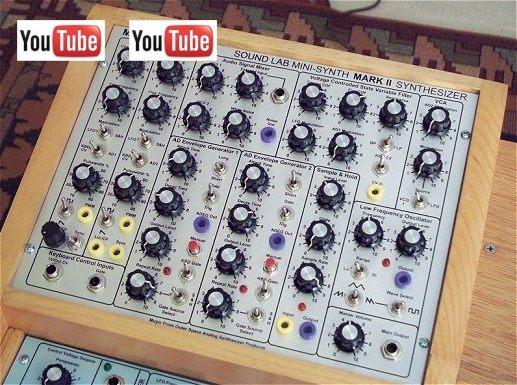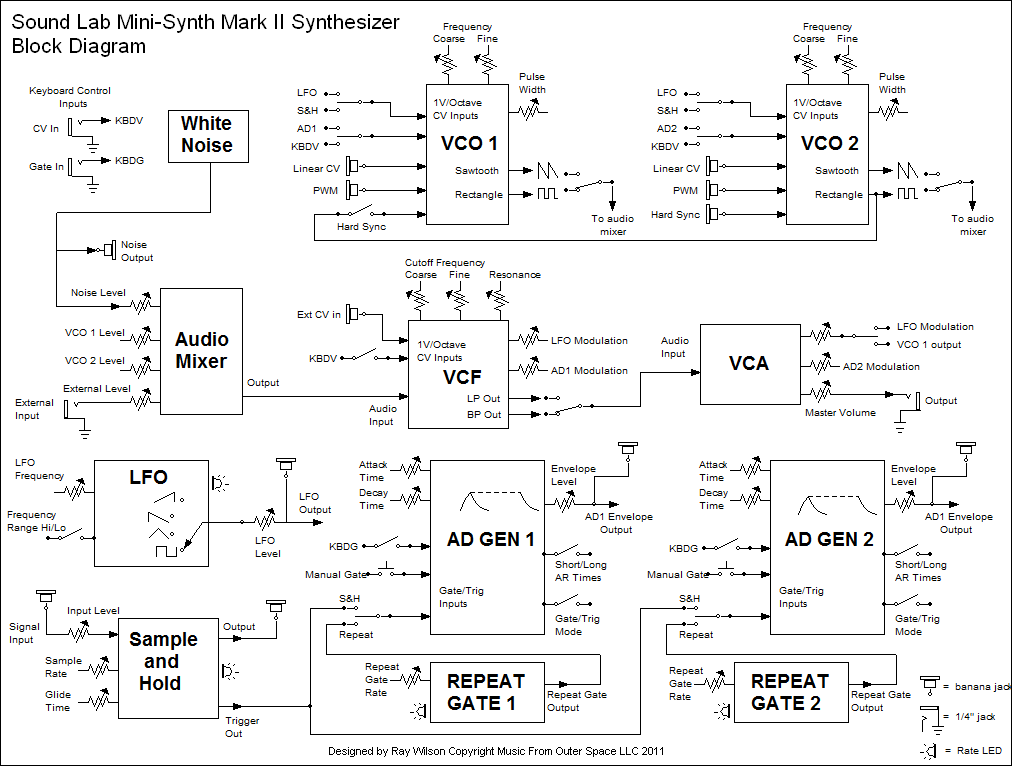Ray Wilson authored this content while he was actively running MFOS as the founder and resident genius.
We retain the content because it reflects a valuable point of view representing that time and place.
Article by Ray Wilson
Features
Sound SamplesSONAR Producer Edition used for mix down of all multi-track samples. All sounds are from the Sound Lab Mark II driven via a MIDI to CV convertor or MFOS Single Buss Keyboard Controller (except the last one).
Prelude and Fugue in C No. 2 - J.S. Bach Three Part Invention in C No. 1 - J.S. Bach |

|
Introduction
I have been wanting to design a new synthesizer that grew from the roots of the popular Sound Lab Mini-Synth design. The Sound Lab Mini-Synth Plus was the first attempt to get more mileage out of the original Sound Lab Design but the Sound Lab Mini-Synth Mark II is what I have been wanting to put together for quite a while. It is a completely new single board analog synth design with some excellent features. I believe the Sound Lab Mini-Synth Mark II is going to become a must-have analog synthesizer. I will be offering a professionally manufactured front panel and double sided, solder masked, plated through-hole PC board for this project. I have tried to make it very convenient to add this to your current synth toolbox. You will be really glad you built this synthesizer.Whether you are a Buchla fan (I don't need no stinkin' keyboard...) or a Moog fan (Wow a keyboard, totally awesome!) you will never run out of totally amazing sounds and patches with the Sound Lab Mini-Synth Mark II. It is certain to become one of your favorite synths. The front panel includes patch points so you can experiment and explore new sounds and ideas.
The Sound Lab Mini-Synth Mark II is a great unit for gigs and/or for the studio and you'll never grow tired of the myriad of sounds the unit can produce. Make your music, sound scapes and/or movie sound tracks stand out with authentic vintage analog synth sounds. Put a Sound Lab Mini-Synth Mark II to work for you today.
Block Diagram
View as PDF

Here is why the Sound Lab Mini-Synth Mark II should be your next synth-DIY project
Two 1V/Oct Tracking VCOs
As you can see from the block diagram each 1V/Octave tracking oscillator has linear CV, hard sync, and pulse width modulation inputs. In addition the oscillators are wired for normallized connections to the LFO, S&H, AD/AR Generator, and KDB voltage. Sawtooth and rectangle waveforms are available from each of the oscillators. These oscillators track really well (6 or more octaves).
White Noise Source
There is a white noise source for all of your favorite non-tonal sounds, modulating other modules, and connection to the Sample & Hold module. The non-attenuated white noise is available via a banana jack.
Audio Mixer
The audio mixer combines the outputs of the two vcos, white noise, and external input and feeds them into the state variable filter. The external input allows you to modify the sounds of your existing keyboard or guitar.
State Variable VCF
The state variable filter has low pass and band pass response outputs and can double as a sine wave oscillator with excellent 1V/Oct tracking. There are several normalized modulation options for the VCF including keyboard control and an external CV in jack. The VCF includes Coarse and Fine COF controls. The VCF's output is fed to the input of the VCA.
Voltage Controlled Amplifier
The VCA has several normalized modulation options including modulation by VCO 1 for some great ring modulation type effects.
Low Frequency Oscillator
The LFO has ramp, saw, tri, and square outputs for lots of cool modulation possibilities. A range switch lets you go from ultra low frequency to higher frequencies again providing flexibility in modulation options. The attenuated LFO output is available via a banana jack. An LED lets you know what the rate is set to.
Two AR/AD Envelope Generators
The two AD/AR generators provide for a wide range of envelope modulation possibilities. One is normalized for controlling the VCF and the other is normalized for controlling the VCA. Both have normalized connections to the Sample & Hold's trigger outputs, repeat gate generator, or keyboard gate input. Gated (attack-hold-release) and Triggered (attack-decay) modes are selectable. The manual gate button helps you audition envelopes or create sound effects. Attack and decay times have a wide range and the long and short range switch adds flexibility. Each AD/AR envelope generator has a dedicated repeat gate generator each of which has an LED to let you know the current repeat rate.